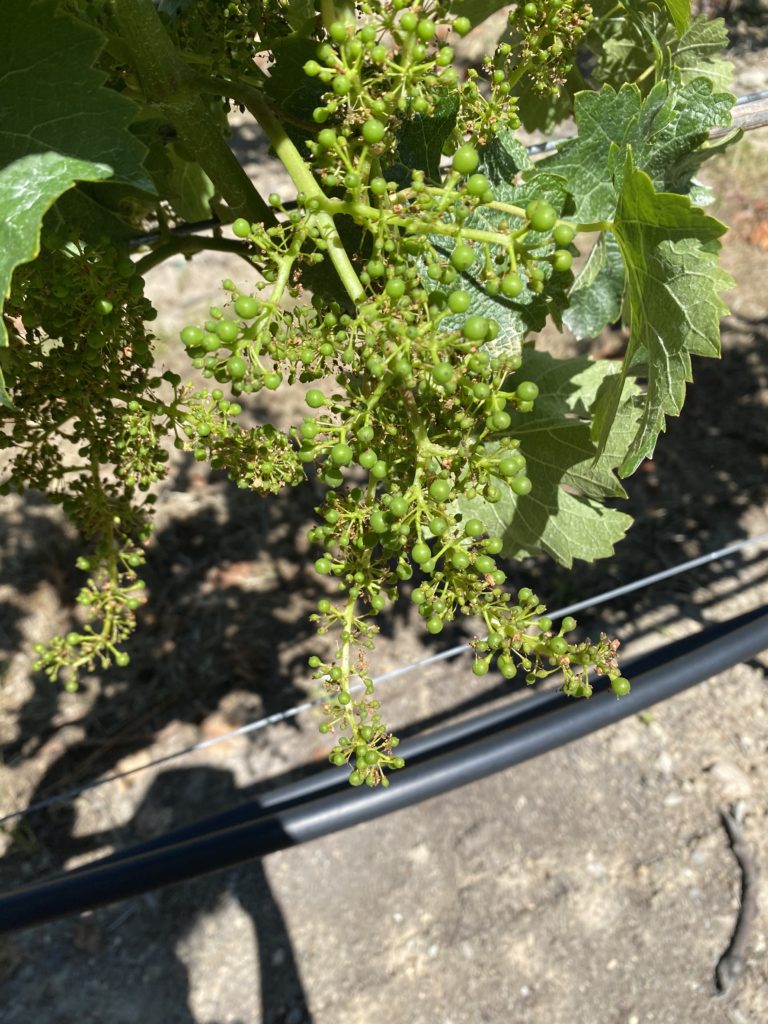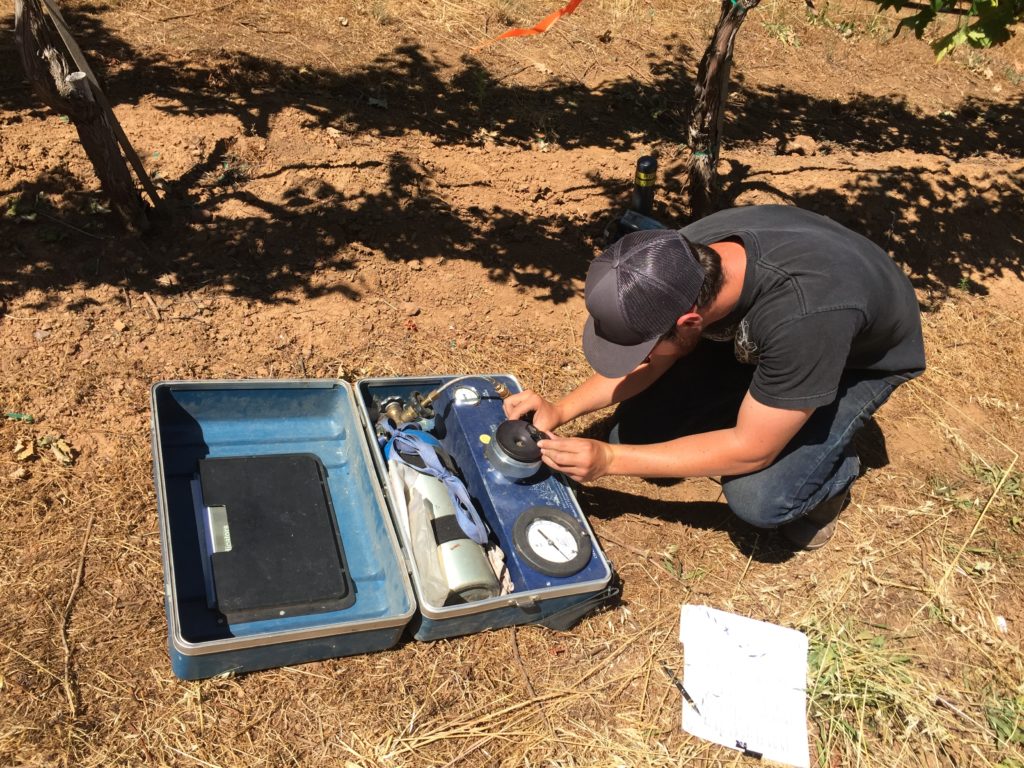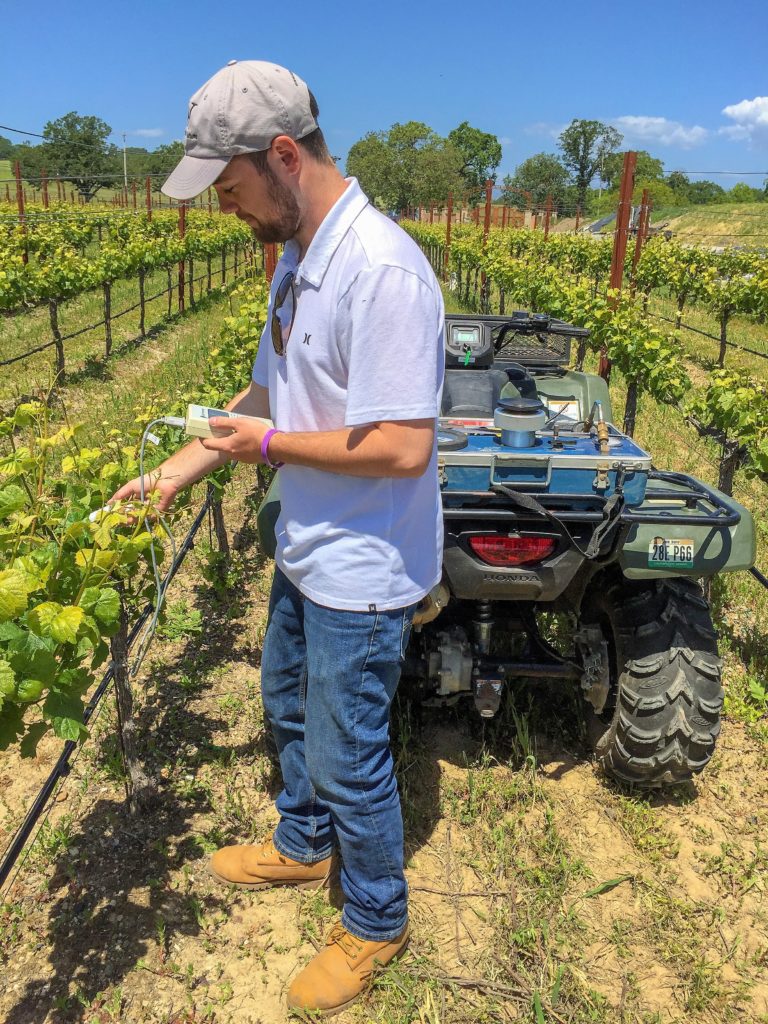Breaking Down Plant Stress
There's no substitute for boots on the ground...yet
By Dr. Mark Greenspan and Loni Lyttle
Here at AV, we make our irrigation recommendations based on three primary pieces of information: soil moisture dynamics, leaf water potential, and stomatal conductance. We also look at the vine (shoot length and elongation and foliar stress symptoms) and look at the weather forecast to aid in our decisions about irrigation. Soil moisture is easy to figure out by way of capacitance probes. Under a thousand bucks will get you one of these, and with it you’ll gain a good idea of how much water your soil has at eight different depths, how much is left in the profile and how much and how often to irrigate. That’s a good start, but it’s not everything. In order to get a real picture of what’s happening in your vineyard, you need to know how the plants are reacting to soil moisture and their above-ground environment. The best way to gather that intel is to send a plucky young intern out on an ATV to retrieve data every week. This is tedious and expensive, but so far the corner-cutting options out there give only an incomplete picture. Before we get into that, let’s go over what it is we’re measuring and why they’re important.
Why do we want to know about plant water stress?

Water stress at the right time drives phenolic synthesis but can also cause problems if it’s too much and/or too early. You want to start off the season with happy vines to ensure even shoot emergence, uniform growth and good fruit set. After that stage, you want to ratchet up the stress. Polyphenol (Tannin) synthesis occurs up to veraison, so if you want good structure and mouthfeel, you’re going to want to make sure the soil has time to dry down and stress the vines (LWP somewhere around -14 to -15 bars, stomatal conductance around 150*-ish for Cabernet, less severe for Pinot and white varieties (read more to understand what the hell this means)). Once veraison begins, phenolic synthesis switches over to anthocyanin production. However, the water stress that stimulates tannin synthesis also upregulates enzymes for anthocyanin (pigment) synthesis. So, water stress during lag phase of berry development through veraison is ideal for red wine production. After veraison, aim for moderate stress levels (LWP around -12-13 bars, stomatal conductance around 200*) until harvest.
Leaf Water Potential
During the growing season, water is sucked through the vine: pulled out of the soil by the roots, transferred to the leaves via the woody parts, and delivered to the leaves via the shoots. The movement of water through the vine is motivated from evaporation from the leaves (a.k.a. transpiration). As the soil dries down and water become scarce, the energy level of water in the leaves (a.k.a. water potential) needs to drop to maintain sap flow and transpiration. There are other factors in play here, such as the resistance to flow through the vascular system (hydraulic resistance) as well as local adjustments in solute concentrations within the leaves (osmotic adjustment) that affect the leaf’s water potential. You can measure the energy level of the water in the leaf (leaf water potential) using a pressure chamber (formerly called a Scholander bomb…but we can’t say bomb anymore…they’re listening).
How does it work? You pick a sample leaf, wrap it up in plastic to temporarily stop the transpiration flow, and put it in the chamber with its stem sticking out. Then you squeeze that lemon, baby, until you see the first tiny droplet of water sputter out of the cut stem. Whatever pressure you had to apply is the negative of the “leaf water potential” (LWP). We commonly refer to the units of water potential in bars, though scientists publish it in Megapascals (MPa). This is important to know if you read scientific literature on plant water relations. A completely unstressed vine can have a LWP as high as -6 bars. As the soil gets dry and the vine starts struggling, you’ll see that number drop to -14, -15 or even -16. Anything lower than that and your vines are in dangerous territory.

Stomatal Conductance
Stomata are the tiny little mouth-shaped pores on the underside of the leaf. This is where carbon dioxide flows into the leaf to fuel photosynthesis and oxygen flows out. Water that evaporates inside the leaf also diffuses out of these pores in a process called transpiration. Stomatal conductance (SC) refers to the ease at which the leaf lets those gasses pass through. You can measure SC with a device called a porometer. The porometer measures the vapor flow out of the leaf and internally computes the resistance to flow – really it’s measuring a collection of a whole lot of tiny stomatal pores in the leaf, about 200 of these little pores per square millimeter of leaf area! While we are measuring the resistance to vapor flow, we usually express resistance by in its inverse, or ease of flow: conductance.


When the vine gets stressed, these pores close to conserve water loss at the expense of the gas exchange needed to drive photosynthesis. Every variety reacts a little differently. Grenache for example closes up at early signs of water stress, whereas Syrah just keeps them open like nothing bad is going to happen, ever. Syrah is basically the Alfred E. Newman of grapevines. For this reason, it’s hard to get an across-the-board correlation between LWP and SC. Hence, it’s good to measure both and that is exactly what we do here at AV.
*stomatal conductance can be described by several different units, but the one most commonly used in practice, and in science, is millimoles per square meter per second (mmol m-2 s-1). That’s a mouthful, but you don’t have to repeat it every time, you know.
An automated solution?
As I mentioned, gathering this information sucks. The data is collected from 11 am to 3 pm on hot, sweaty, summer days. Finding the personnel willing to do this job and do it well is a challenge. When you do, they’re expensive. Maintaining your equipment is pricey too, especially when the ATV falls off the back of the truck because your intern was Tik Tokin’ while loading up. (Just kidding, this hasn’t happened yet).

There are numerous automated technologies out there that tout being able to substitute for the hard, sweaty data collection of LWP and SC. Measuring field-scale evapotranspiration (ET, canopy transpiration plus soil surface evaporation) and comparing it to a modeled version of unstressed ET for use as a stress index has shown promise, but the modelling is fraught with sources of approximations and error. Plant-based automated sensors, such as sap flow sensors, dendrometers and micro-tensiometers have also shown very interesting relationships with respect to levels of plant stress. Of those, we’ve seen the most promising results from micro-tensiometers, but we’re not yet seeing full agreement with our standard instruments yet. We need to ground-truth any sensor before we feel confident in changing our approach.


Infrared sensing of canopy temperature has been used for decades and has shown promise in its correlation with stomatal conductance in grapes. Hell, Mark did his Ph.D. research using infrared sensing of grape canopies way back when Noah was planting the first grapevine after the flood. There are still problems with it – largely because the infrared signal comes not only from leaves, but from soil and background, which have vastly different temperatures than the leaves.
Conclusion
I don’t want to give you the impression that we’re luddites here at AV, far from it! We love new technology, the mechanical loom included. Our dream is to have an automated system for collecting continuous data on plant stress that we can view from the comfort of the couch, or at least our office chair. That way, we can put those interns to work doing more important things, like serving me cocktails and teaching me to use the buttons on my phone. Accuracy, repeatability, and durability, however, must come first before we put our pressure chambers and porometers on the shelf.



When I initially left a comment I appear to have clicked on the -Notify me when new comments are added- checkbox and from now on whenever a comment is added I recieve four emails with the exact same comment. Is there a way you can remove me from that service? Appreciate it!| Charissa Port Latoyia